AMD’s Radeon HD 5770 & 5750: DirectX 11 for the Mainstream Crowd
by Ryan Smith on October 13, 2009 12:00 AM EST- Posted in
- GPUs
Power, Temperature, & Noise
With the 5700 series being built using TSMC’s 40nm process, and with their low target power, we should see some interesting results here.
We do need to note however that thanks to some badly timed broken hardware, we’re using our secondary test rig for noise and temperature data, so the results are not directly comparable to our 5800 series reviews. As a result we also only have power data for the 5770; we weren’t able to get power data on the 5750 in time for this article.
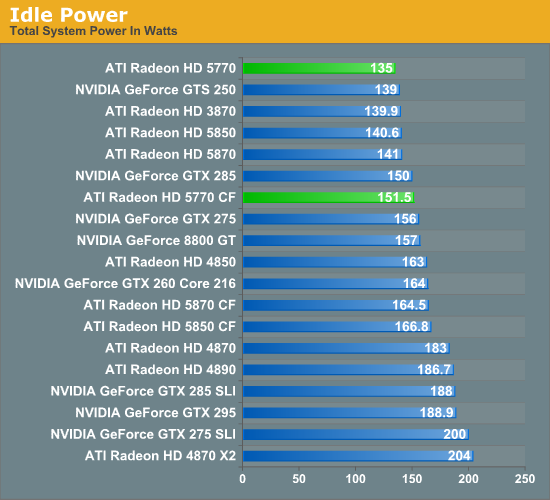
Thanks to the 40nm process and relatively simple nature of Juniper, the 5770 turns in the best idle power usage of all of our mainstream and high-end cards. At 135W it edges out the GTS 250, the 3870, and its bigger brothers the 5800 series. Coupled with a good CPU, and this should result in a system with very good idle power usage for the performance levels it provides.
We can also see the low power usage of an individual 5770 in our 5770 CF usage. There's a 16.5W difference, as the slave card gets to power down even further than 18W.

At 256W for load power, the 5770 isn’t quite the winner here like it is for idle power. The 3870 beats it by 14W at the cost of a significant degree of performance, while the 8800GT is neck-and-neck with the 4770, again with a decent-sized performance gap. Everything past here approaches 300W and beyond. As a result, even if it’s not the least power hungry card we have, it’s very close, and it’s certainly among the best for on a power-to-performance ratio.
Meanwhile looking at the Crossfire results, we see that there's a 134W difference between cards. As the Evergreen architecture allows us to go higher so long as the VRMs are safe, this appears to that situation in action.
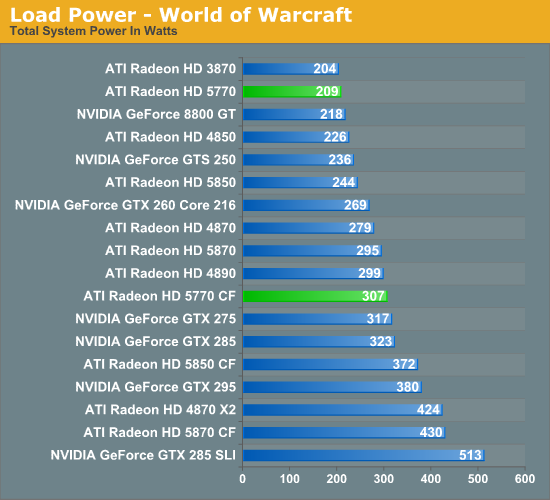
World of Warcraft gives us similar results. The 5770 still doesn’t come out on top, but its bested only by the 3870 and its significantly lower performance. The gap on the other side isn’t particularly large either, but the first card that can beat the 5770’s average gaming performance doesn’t show up until we hit the 5850.
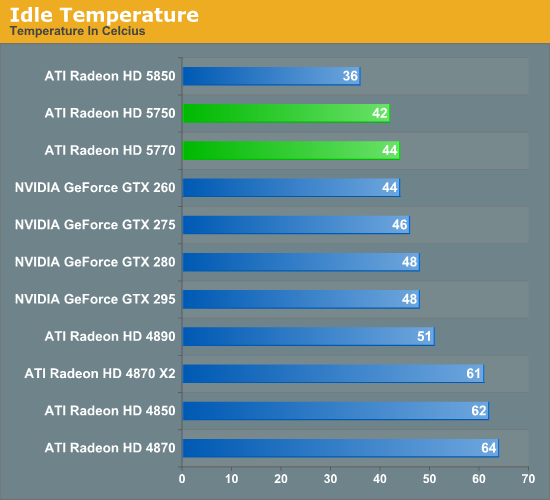
The 5700 series turns in some of our best idle temps, tying or beating everything besides a 5850. In fact we’re a bit surprised to see a 5850 win here given the lower idle power usage of the 5700 series, but the data doesn’t lie.
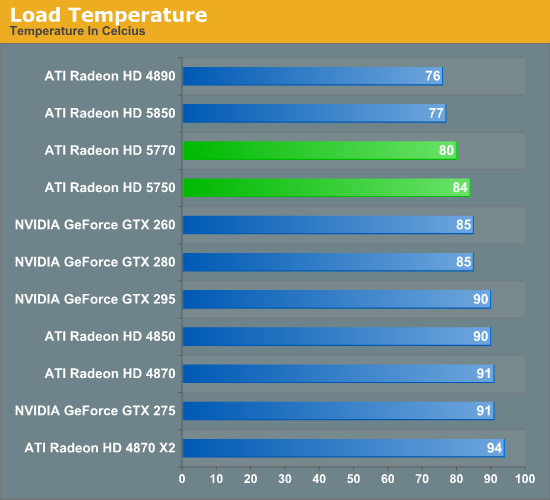
It’s load temperatures where all of the action is at. Again the 5700 series do quite well here, only losing to the 5850 and a very loud 4890. Compared to the rest of the 4800 series in particular, we’re a good 6C-11C cooler for a set of cards that offer similar to slightly less performance. Aren’t smaller manufacturing processes great?
However in spite of the 5750’s lower power consumption, it doesn’t do so well here in terms of temperature compared to the 5770, coming in 4C hotter. We’re going to chalk it up to the egg cooler being unable to match the 5770’s shrouded cooler. This of course makes the fact that the 5770’s shrouded cooler is going to eventually go away all the more meaningful, as conceivably the replacement coolers would end up being less effective.
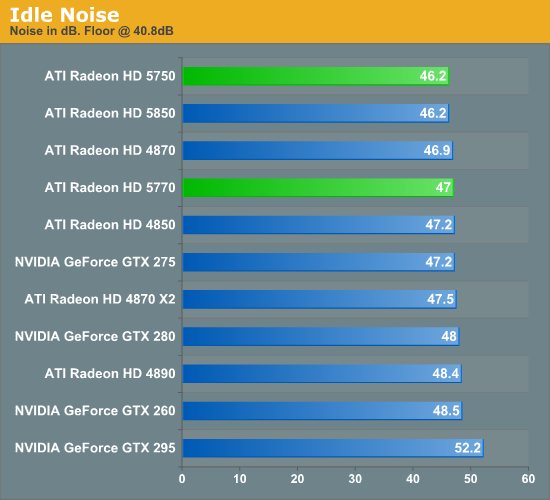
As is the case for most of the cards we test, at idle they’re virtually all the same. The 5700 series are no exception to this rule.
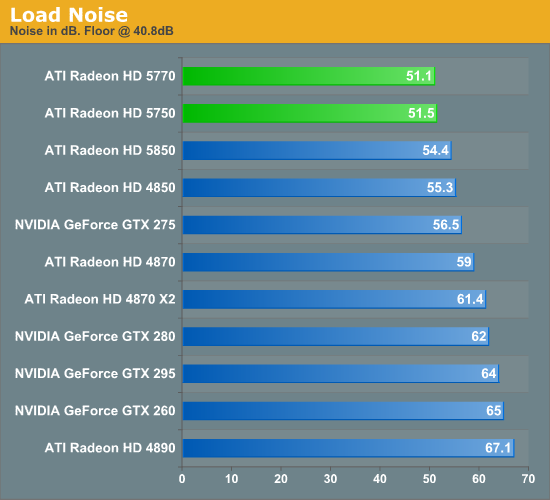
With the low power consumption of the 5700 series, their coolers don’t have to work very hard to reach their already low load temperatures. At 51dB, these are the quietest cards we’ve tested at this level of performance; we would need to drop down to something slower yet (like yesterday’s GT 220) to find something quieter.
We also can’t rule out the possibility of the 5750 going passive in the future, given its already dainty cooler. We’ve seen it done before on an 8800GT, which has a similar thermal envelope. This certainly has all the makings of the fastest passively cooled card on the market, if someone can build the right cooler.
This also leaves the door open to the idea of using the 5750 as an HTPC card. With bitstreaming audio support it’s the best HTPC card we’ve tested yet from a features standpoint, but we’re not convinced that it’s going to be the best thing out there given it’s >$100 price tag and the fact that it’s still power-hungry enough to need a PCIe power connector. In the long-term the 5600 series may be a better replacement given the same features and lower power consumption that a lower-performing part will offer, but that’s something we won’t be able to test until next year.










117 Comments
View All Comments
flipmode - Tuesday, October 13, 2009 - link
What in the world is going on with this game? 8800 GT beats the 4850? No, sorry, I don't buy that. Something is wrong here. The 5770 beats everything? If that is the case, then this game should immediately be removed from the bench suite - games in the bench suite should help us understand the general performance characteristics of the hardware and a game that returns such erratic results actually distorts that understanding.Griswold - Tuesday, October 13, 2009 - link
On page 13 you say:"The 3870 beats it by 14W at the cost of a significant degree of performance, while the 8800GT is neck-and-neck with the 4770, again with a decent-sized performance gap."
You certainly meant 5770 there. But this brings me to a question: Why isnt the 4770 included here? As an owner of that card, I'm very much interested in the performance/power/noise difference - just ditch one of the relatively irrelevant SLI or CF combos. I dont think too many care about comparing high-end multi-GPU with performance parts such as the 5770 and 5750, even if its 57xx in CF.
flipmode - Tuesday, October 13, 2009 - link
Ryan - thanks so much for the review. Nice job. It does seem like a 5750 Crossfire would be an interesting value - moreso than the 5770 since the latter is overpriced.And, Anand, I love your site, and don't take this personally, but, PLEASE GET A COMMENT SYSTEM THAT DOES NOT TOTALLY SUCK!
Check out TechReport for an example of the awesomest comment system in the universe.
PLEASE!
Ryan Smith - Tuesday, October 13, 2009 - link
AMD only sent out 1 5750, so I don't have a second one to Crossfire at this time.Roland00 - Tuesday, October 13, 2009 - link
It makes no sense (beside bad drivers) for the 5770 to lose to the 4850. The 5770 has more memory bandwidth (76.8) compared to the 4850 (63.55 gb/s), due to the 4850 sticking with ddr3, even with the 128 bit bus. The 5770 is also clocked 36% faster than the 4850 (850 vs 625).Yet the 5770 underpeforms the 4850 being almost tied?
Zool - Tuesday, October 13, 2009 - link
Maybe the 4*64bit memmory controlers on the perimeter of the chip keep up the data better than 2*64bit controlers with higher bandwith.I think that they could make it at least 192 bit (3*64bit).
Zool - Tuesday, October 13, 2009 - link
Actualy where the hell are the Cypress and Juniper die shots ?I cant find a single one on net.
Ryan Smith - Tuesday, October 13, 2009 - link
AMD is not releasing die shots.dgz - Tuesday, October 13, 2009 - link
Looks to me like AMD is trying to lure people into buying the remaining 48** cards. Once the old chips are cleared, the price of 57** will no doubt drop.GrizzlyAdams - Tuesday, October 13, 2009 - link
What really has me concerned is how the 5870 is scaling in these tests.The 5870 core is essentially two 5770s strapped together, and you would hope scaling would be near linear. When two 5770s in crossfire match or even beat a 5870 I'm left scratching my head.
Somewhere there is a significant bottleneck in the 5870's design, and I'm wondering where that is. Anyone have any clue?
Hopefully a driver update will fix these issues, because if not there is a lot of wasted silicon on each of these chips...